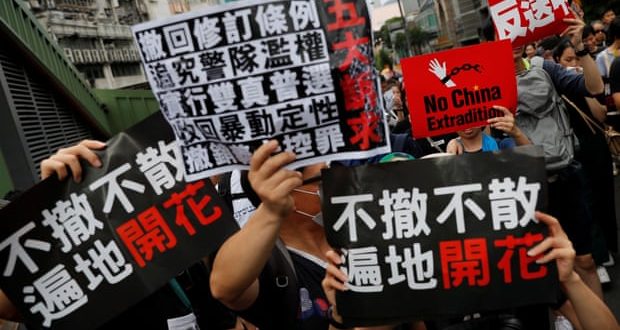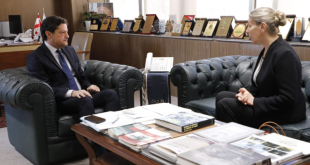Police in riot gear beat protesters as demonstration continued into late evening
Conflict has broken out between hundreds of protesters and police in riot gear in Hong Kong after tens of thousands of protesters marched peacefully earlier in the day to keep up the pressure on the government to withdraw its controversial extradition bill.
The march, which continued late into the night, was the first since the storming and vandalising of Hong Kong’s legislature by protesters last Monday, a move that drew strong condemnation from the Chinese and Hong Kong governments. The extradition bill – which would allow suspects to be removed from the semi-autonomous city to face China’s flawed justice system – has been the subject of several mass rallies over the past month.
The demonstration descended into chaos shortly before 11pm local time on Sunday with most protesters retreating and yelling “Leave now! Leave now!” as police in riot gear began to advance towards them. Police used truncheons to beat protesters, who were trapped as police advanced towards them in both directions, and pressed some of them on to the ground.
Six people were arrested, according to a statement from the police just after 3am Monday morning. One protester was detained for “failing to produce proof of identity” and the five others were arrested for assaulting a police officer or obstructing the police.
“Police respect the public’s freedoms of expression, speech and assembly. It is the policy of the police to facilitate all peaceful public events while at the same time ensuring public safety and public order. Police strongly condemn the illegal acts of protesters for blocking the roads,” the statement said.
The atmosphere had turned tense earlier, with protesters who armed themselves with umbrellas and police in riot gear locked in a stand-off in the commercial district of Mongkok.
The march – which had been given official permission by the police – started around 3.30pm local time at a park by the harbour front at Tsim Sha Tsui on the Kowloon peninsula, an area popular with tourists. Organisers estimated as many as 230,000 participated in the march, more than was expected. Police said only 56,000 attended.
Although it officially ended by early evening, when most of the crowds dispersed after reaching the West Kowloon railway terminus, where high-speed trains link Hong Kong with Chinese cities, protesters began to fill the commercial area in Tsim Sha Tsui in the evening.
Late into the evening, protesters continued to march down Nathan Road, the main thoroughfare in Kowloon, occupying half a street. They chanted slogans as they marched northwards, passing Yau Ma Tei and heading towards Mong Kok. After reaching Mongkok, police in riot gear formed into a line to stop protesters from advancing and demanded that they left.
“Cruel police! Cruel police!” chanted protesters, wearing goggles, masks and holding up umbrellas to shield themselves in case police shot tear gas.
“I’d rather sit at home enjoying air-conditioning in this hot weather, but it is the government who forced us to keep protesting,” said a young man who declined to be identified.
Although Hong Kong’s leader Carrie Lam has offered to meet university student representatives behind closed doors, he said she had showed no sign of giving in to any of the protesters’ political demands and he was tired of Lam “sounding like a broken record” in her reiteration of her position.
Hong Kong’s leader, Carrie Lam, has apologised for the crisis, but protesters have demanded that the government fully withdraw the bill and release all those arrested in previous protests.
They also want the government to launch an independent investigation into the police’s use of force on 12 June, when teargas, rubber bullets and truncheons were used on largely peaceful crowds. Protesters also called on the government to implement universal suffrage.
“We want genuine universal suffrage!”, “Free Hong Kong!”, “Hong Kongers, go for it!”, and “Retract the bill!”, chanted the spirited and noisy crowds to the rhythms of occasional drum beats earlier in the day.
Some held up yellow banners and umbrellas to call for universal suffrage. Several waved giant colonial-era flags – which include the British union flag – while others and blue flags emblazoned with “Hong Kong Independence”.
Umbrellas were the symbol of the last major set of protests in Hong Kong, the 79-day Umbrella Movement in 2014, which demanded an unfettered vote for ordinary citizens after China ruled that all candidates for Hong Kong’s top leadership job must receive over half of the votes from a largely pro-Beijing nominating committee of 1,200 members, which would select two or three candidates, before going before voters. The civil disobedience movement failed to press Beijing to grant genuine universal suffrage and this has become a source of political tension ever since.
“I am here to support the young people. It is our fault that we hadn’t spoken out earlier to fight for more freedoms so the task is upon the young now. And they’re so desperate and despondent,” said 68-year-old Mary, who did not wish to give her last name, referring to last Monday’s storming of the legislature building.
Hong Kong’s authorities appeared nervous that Sunday’s march might turn violent. Police erected giant water-filled barricades outside the West Kowloon railway terminus and closed many entrances to stop protesters from getting in. They also closed and diverted several roads in the area for the protest. The railway company suspended sales of tickets for high-speed trains to and from the terminus on Sunday afternoon.
Emotions have been running high in Hong Kong over the past month during its biggest political crisis in decades. Millions of people have thronged the streets to protest against a proposed law allowing for the extradition of individuals to mainland China, where courts are controlled by the Communist party.
Tensions erupted last Monday, the anniversary of Hong Kong’s 1997 return from British to Chinese rule, when hundreds of angry protesters stormed and vandalised the legislature. Police fired teargas after midnight to disperse them.
Protesters on Sunday said even though police had started arresting people involved in earlier protests, it would not dampen their resolve. “We will keep coming out until the government respond to us. If they keep ignoring us, people can only escalate their fight,” said a young woman who gave her name as Mimi.
“The government doesn’t give a damn about us – protesting is our only hope,” said Vivian Li, a mother of two toddlers.
The Guardian
 Lebanese Ministry of Information
Lebanese Ministry of Information



